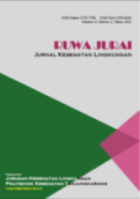Spatial Analysis of Breeding Places of Anopheles sp. Mosquitoes as Potential Vectors of Malaria Infection in Pesawaran District, Lampung, Indonesia
DOI:
https://doi.org/10.26630/rj.v19i1.4968Keywords:
Malaria, Spatial, Environmental, Breeding placeAbstract
Malaria is an infectious disease caused by microorganisms of the genus Plasmodium, transmitted to humans by the female Anopheles mosquito species. The breeding place of this Anopheles mosquito is typically found in the environment, such as stagnant water in rivers, abandoned ponds, lagoons, and other similar areas. Pesawaran Regency is a malaria-endemic area in Lampung Province with an API of 1.4 in 2023. Mapping the distribution of breeding places is necessary to control malaria vectors in Pesawaran Regency. Based on this, this study will conduct a spatial analysis of the breeding sites of Anopheles sp. mosquitoes, which are potential vectors of malaria infection in Pesawaran District. This type of research is descriptive observational using cross sectional design, coordinate survey and visual inspection of larvae found in breading place and spatially processed using Arcgis V.10.8. From the observations of breeding places in the form of swamps, water reservoirs (buckets and derigen) unused fish ponds or ponds, buffering breeding place analysis carried out can be seen that malaria cases are in the area of vector flight distance of 1,000 meters and 3,000 meters. Potential breeding places were found in Teluk Pandan sub-district of Pesawaran Regency, breeding places are scattered in five villages and are located in coastal areas with a distance between 407.88 meters - 707.266 meters from the coastline, buffering analysis of breeding places can be seen that the location at risk of malaria case transmission is in the vector flight distance area of 1,000 meters and 3,000 meters covering eight villages.
References
Achmadi, U. F. (2009). Manajemen Penyakit Berbasis Wilayah. Jurnal Kesehatan Masyarakat, 16424, 147–153. https://doi.org/10.21109/kesmas.v3i3.228%0A%0A
Aida, P. N., Astuti, F. D., & Azka, A. (2023). Keanekaragaman Spesies dan Bionomik Anopheles spp. pada Daerah Endemis Malaria di Indonesia. ASPIRATOR - Journal of Vector-Borne Diseases Studies, 14(2), 89–104. https://doi.org/10.58623/aspirator.v14i2.11
CDC. (2023, Agustus 3). http://www.cdc.gov/malaria/about/biology/parasites.html. Retrieved from http://www.cdc.gov/malaria/about/biology/parasites.html: http://www.cdc.gov/malaria/about/biology/parasites.html
Deviani Utami, Tusy Triwahyuni, Y. J. (2019). Hubungan Lingkungan Rumah Dengan Kejadian Malaria Di Desa Sidodadi Kabupaten Pesawaran Tahun 2018. Jurnal Ilmu Kedokteran Dan Kesehatan, 6, 216–223. https://doi.org/10.33024/jikk.v6i3.2269
Dhewantara. Pandji Wibawa, Astuti. Endang Puji, P. F. Y. (2012). studi Bioekologi Nyamuk Anopheles Sundaicus Di Desa Sukaresik Kecamatan Sidamulih Kabupaten Ciamis Litbang Pengendalian Penyakit Bersumber Binatang ( P2B2 ) Ciamis BIOECOLOGY STU. Buletin Penelitian Kesehatan, 41, 26–36.
DEPKES RI. (2001). Gebrak Malaria. Jakarta: Sub Direktorat Malaria, Direktorat Jenderal Pemberantasan Penyakit Manular dan Penyehatan Lingkungan Pemukiman, Departemen Kesehatan Republik Indonesia.
Dinkes Kab. Pesawaran, D. K. (2023). Profil Kesehatan Kabupaten Pesawaran. Pesawaran: Dinkes Kabupaten Pesawaran.
Dinkes Provisi Lampung, D. P. (2023). Profil Kesehatan Provinsi Lampung. Bandar Lampung: Dinkes Provinsi Lampung.
Dinas Kesehatan Pesawaran. (2024). Profil Kesehatan Kabupaten Pesawaran 2023. 1–195.
Ginandjar, P. (2018). Faktor Lingkungan Yang Berkaitan Dengan Kejadian Malaria (Studi Di Wilayah Kerja Puskesmas Kepil I Kabupaten Wonosobo Tahun 2004). Jurnal Kesehatan Lingkungan Indonesia, 4(1), 1–8. https://doi.org/10.14710/jkli.4.1.1 - 8
Hasyim, H., Camelia, A., & Fajar, N. A. (2014). Determinan Kejadian Malaria di Wilayah Endemis. Kesmas: National Public Health Journal, 8(7), 291. https://doi.org/10.21109/kesmas.v0i0.367
Kazwaini, M., & Martini, S. (2015). Tempat Perindukan Vektor Spesies Nyamuk Anopheels dan Pengaruh Tempat Perindukan Terhadap Kejadian Malaria. Jurnal Kesehatan Lingkungan, 2(2), 173–183.
Kementrian Kesehatan. (2023). Profil Kesehatan. 100.
Lampung Provincial Health Office. (2024). Health Profile 2023 Lampung Provincial Health Office. 44, 1–326.
Maya Tindige, Joy V. I. Sambuaga, dan S. J. S. (2017). Studi Spasial Keberadaan Breeding Places Dengan Kejadian Malaria Di Desa Bulude Kecamatan Kabaruan Kabupaten Kepulauan Talaud. https://doi.org/10.47718/jkl.v8i2.676
Notoatmodjo, S. (2010). Metodologi Penelitian Kesehatan. Jakarta: Rineka Cipta.
Shilpa Hakre. (2003). The Epidemiology of Malaria in Belize, 1989 -1999. Zitteliana, 19(8), 159–170.
Suwandi, J. F., Supargiyono,  , Asmara, W., & Kusnanto, H. (2014). Mapping and Prevalence of Malaria Falciparum Patients with ACT Failed Therapy, in Hanura Public Health Center, Pesawaran, Lampung, Indonesia. Open Journal of Epidemiology, 04(03), 169–177. https://doi.org/10.4236/ojepi.2014.43023
Suyono, R., Salmun, J. A. R., & Ndoen, H. I. (2021). Analisis Spasial Tempat Perindukan Nyamuk, Kepadatan Larva dan Indeks Habitat dengan Kejadian Malaria di Kecamatan Waigete Kabupaten Sikka. Media Kesehatan Masyarakat, 3(1), 1–11. https://doi.org/10.35508/mkm.v3i1.3146
Taher, A., Triwahyuni, T., Husna, I., & Febriani, D. (2021). Karakteristik Fisik, Kimia, Dan Biologi Tempat Perindukan Potensial Larva Anopheles Sp. Dan Indeks Habitat Di Desa Sukamaju Kecamatan Punduh Pidada Kabupaten Pesawaran. MAHESA : Malahayati Health Student Journal, 1(2), 122–133. https://doi.org/10.33024/mahesa.v1i2.3819
Downloads
Published
How to Cite
Issue
Section
License
Copyright (c) 2025 Ruwa Jurai: Jurnal Kesehatan Lingkungan

This work is licensed under a Creative Commons Attribution-NonCommercial 4.0 International License.

Ruwa Jurai: Jurnal Kesehatan Lingkungan is licensed under a Creative Commons Attribution-NonCommercial 4.0 International License.
Authors who publish with this journal agree to the following terms:
- Authors retain copyright and grant the journal right of first publication with the work simultaneously licensed under a Creative Commons Attribution-Non Commercial License that allows others to share the work with an acknowledgment of the work's authorship and initial publication in this journal.
- Authors are able to enter into separate, additional contractual arrangements for the non-exclusive distribution of the journal's published version of the work (e.g., post it to an institutional repository or publish it in a book), with an acknowledgment of its initial publication in this journal.
- Authors are permitted and encouraged to post their work online (e.g., in institutional repositories or on their website) prior to and during the submission process, as it can lead to productive exchanges, as well as earlier and greater citation of published work.









